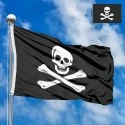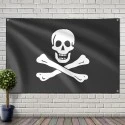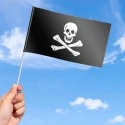- All Flags
- Flags of Countries by Continent
-
Flags of Organizations
- Flags of UN countries
- Flags of the European Union countries
- Flags of NATO countries
- Flags of the countries of the Organization of Islamic Cooperation
- Flags of the countries of the Organization of American States
- Flags of the Arab League countries
- Flags of the African Union countries
- Flags of the countries of the Union of South American Nations
- Flags of the Commonwealth of Nations
- Flags of the countries of the Secretariat of the Pacific Community
- Flags of the Nordic Council countries
- Flags of the Caribbean Community
- Flags of the countries of the Association of Southeast Asian Nations
- Flags of the East African Community
- Flags of the countries of the Organization of Turkic States
- LGBT Community Flags
- Historical Flags
- Ethnic Flags
- Flags of the USA (states)
Description
The flag of pirate captain Edward England, a notorious figure of the Golden Age of Piracy, is one of the most recognizable and enduring symbols of the pirate era. As a variant of the iconic Jolly Roger, this flag represents not only the threat and fear associated with piracy but also the spirit of rebellion and the unique social contract of a pirate crew. Edward England's flag serves as a powerful historical artifact, telling a story of lawlessness, adventure, and the transient freedom of life on the high seas.
Design and Symbolism
Edward England’s flag is a classic Jolly Roger design, featuring a black field with a central white skull positioned above two crossed bones.
-
The Black Field: The black background was a universal symbol among pirates. It was a stark visual warning of the impending attack and was used to intimidate merchant ships into surrendering without a fight. The color black represented death, fear, and the pirate crew's willingness to grant no quarter to those who resisted.
-
The White Skull: The skull is a timeless emblem of mortality. On the Jolly Roger, it was a clear and unambiguous warning. It signified that those who chose to fight would meet their death at the hands of the pirates.
-
The Crossed Bones: The crossed bones beneath the skull are a symbol traditionally associated with death and danger. In the context of the flag, they served to reinforce the skull’s message, making it clear that the pirates were a force of violence and that their targets were facing mortal peril. The design as a whole was a masterpiece of psychological warfare.
History of Creation and Adoption
Edward England, born Edward Seegar, was an Irish pirate who was active from approximately 1717 to 1720. He was a popular and charismatic captain, known for his relative leniency, though he did not shy away from violence when necessary. His flag was adopted during his command and became the banner under which his crew, including notable pirate John Taylor, sailed across the Atlantic and Indian Oceans.
The flag was not created with a formal adoption process like a national flag. Instead, it was chosen by the crew to serve as their official ensign. It was a declaration of their allegiance to the pirate life and their defiance of the royal and mercantile authority. The flag was a crucial tool for a pirate captain like England, as it was a means to identify his vessel and communicate his intentions to others. Its use on ships like the Fancy and the Pearl cemented its place in pirate history.
Flag Size and Proportions
Like other pirate flags of the era, Edward England's flag did not have standardized proportions. Flags were often hastily made from whatever material was available, such as old sailcloth. The size could vary, but they were typically designed to be large and visible enough to be seen from a considerable distance. This ensured that the warning message was delivered to potential victims well before they could escape. While there were no rules, the proportions likely followed the general patterns of the time, often in a ratio of 1:2 or 2:3.
The Region and its Meaning for the Crew
Edward England’s area of operation was vast, spanning from the coast of Africa to the Indian Ocean and the pirate haven of Madagascar. His crew was a diverse mix of sailors from various backgrounds who had abandoned their former lives in search of freedom and wealth. For them, the flag was more than just a symbol of their captain; it was a representation of their collective identity as a community of outlaws.
The flag symbolized their new "nation" and their freedom from the strict social hierarchy and economic hardship of the world they had left behind. It represented a collective bond and a commitment to the pirate code. The Jolly Roger was a source of pride, a symbol of their solidarity against the forces of law and order, and a defiant statement that they were masters of their own destiny.
Interesting Facts
-
Edward England was known for his relatively merciful nature, a trait that ultimately led to his crew deposing him in favor of the more ruthless John Taylor.
-
He was a key figure in the pirate community of Nassau, before moving his operations to the Indian Ocean, a less-crowded and more lucrative hunting ground.
-
His iconic flag is one of the most recognizable versions of the Jolly Roger and is often used in popular culture to represent piracy as a whole.
-
A famous encounter with Captain James Macrae is said to have led to the design of a less-known flag used by England's second-in-command, demonstrating the flexible and evolving nature of pirate symbols.
Ultimately, Edward England's flag is a powerful and lasting symbol of an era defined by daring adventure, brutal reality, and a unique form of rebellious freedom on the open sea.
In the demonstration images, full-size flags are shown with proportions of 2:3, and hand-held flags with proportions of 1:2.
Donation
Download
Completely free for commercial and non-commercial use (public domain).
You can freely use them in your news magazines, websites, software, mobile applications.
We appreciate a backlink to https://flagssite.com
Raster files - Edward England's Pirate Flag (PNG, JPG)
 Waving flag
Waving flag
- PNG format (transparent background), 72dpi, dimensions in Pixels (px), aspect ratio 3:4.
- 15х20 px
- 30х40 px
- 60х80 px
- 120x160 px
- 240x320 px
 Sizes:
Sizes:
"v15" - image size (by height); if necessary, replace with available: v15, v30, v60, v120, v240.
!!! For resizing, use the Latin (eng) keyboard layout.
<img src="https://flagssite.com/flags/v15/20909.png" alt="Edward England's Pirate Flag">
 Round flag
Round flag
- PNG format (transparent background), 72dpi, dimensions in Pixels (px), aspect ratio 1:1.
"d15" - image size (diameter); if necessary, replace with available: d15, d30, d60, d120, d240.
!!! For resizing, use the Latin (eng) keyboard layout.
<img src="https://flagssite.com/flags/d15/20909.png" alt="Edward England's Pirate Flag">
 Rectangular flag 2:3
Rectangular flag 2:3
- JPG format, 72dpi, dimensions in Pixels (px), aspect ratio 2:3.
"h30" - image size (by height); if necessary, replace with available: h15, h30, h60, h120, h240, h360, h480.
!!! For resizing, use the Latin (eng) keyboard layout.
<img src="https://flagssite.com/flags/h30/20909.jpg" alt="Edward England's Pirate Flag">






 Sizes:
Sizes:
 Sizes:
Sizes: